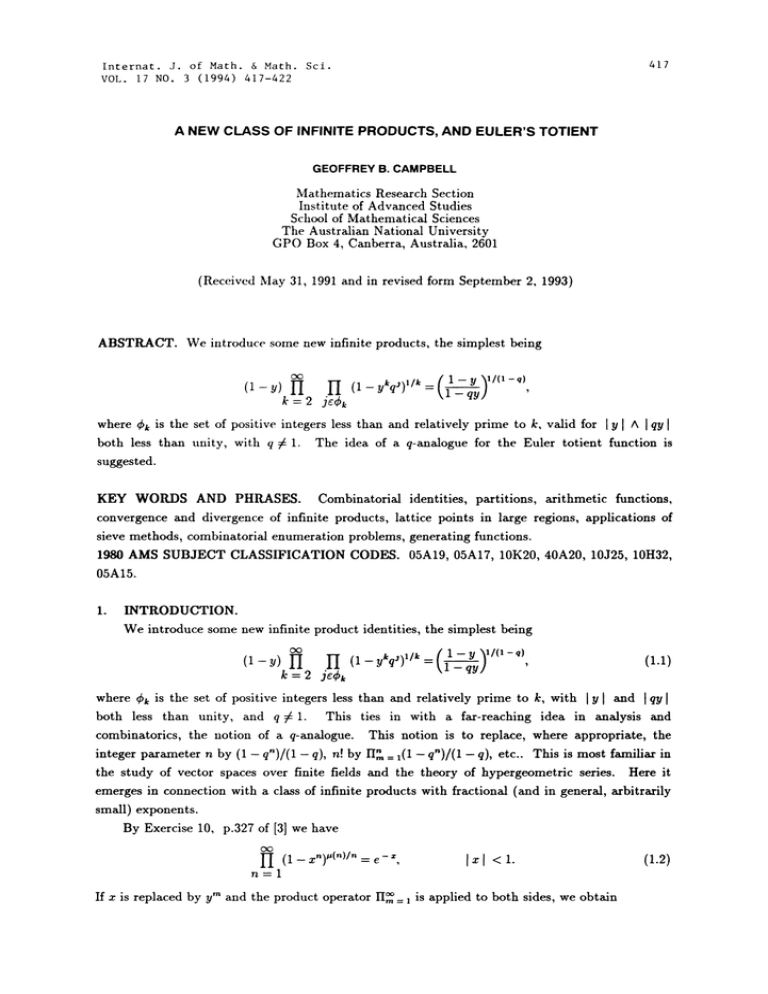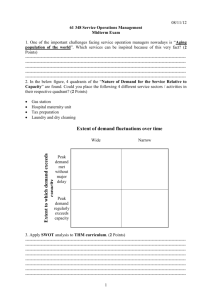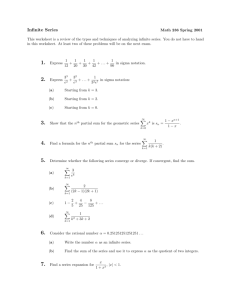Document 10442588
advertisement

417
Internat. J. of Math. & Math. Sci.
VOL. 17 NO. 3 (1994) 417-422
A NEW CLASS OF INFINITE PRODUCTS, AND EULER’S TOTIENT
GEOFFREY B. CAMPBELL
Mathematics Research Section
Institute of Advanced Studies
School of Mathematical Sciences
The Australian National University
GPO Box 4, Canberra, Australia, 2601
(Received May 31, 1991 and in revised form September 2, 1993)
ABSTRACT. We introduce some new infinite products, the simplest being
o0
(
I]
)
k
2
II
( q’)’/
(
_y
q
)l/(l_q)
is the set of positive integers less than and relatively prime to k, valid for
where
both less than unity, with q 1. The idea of a q-analogue for the Euler totient function is
suggested.
KEY WORDS AND PHRASES. Combinatorial identities, partitions, arithmetic functions,
convergence and divergence of infinite products, lattice points in large regions, applications of
sieve methods, combinatorial enumeration problems, generating functions.
1980 AMS SUBJECT CLASSIFICATION CODES. 05A19, 05A17, 10K20, 40A20, 10J25, 10H32,
05A15.
1.
INTRODUCTION.
We introduce some new infinite product identities, the simplest being
(1 --y)
k
H2 H
(1-- ytCq’)l/’
_--
(1.1)
where Ck is the set of positive integers less than and relatively prime to k, with Yl and
both less than unity, and q 1. This ties in with a far-reaching idea in analysis and
combinatorics, the notion of a q-analogue. This notion is to replace, where appropriate, the
integer parameter n by (1- q")/(1-q), n! by H= 1(1- q")/(1-q), etc.. This is most familiar in
the study of vector spaces over finite fields and the theory of hypergeometric series. Here it
emerges in connection with a class of infinite products with fractional (and in general, arbitrarily
small) exponents.
By Exercise 10, p.327 of [3] we have
H (1
n=l
x") u(")/"
If x is replaced by y’ and the product operator
e
-x,
II
I
< 1.
is applied to both sides, we obtain
(1.2)
418
G.B. CAMPBELL
II
(i
yk)(k)/k
-/(-)
(1.3)
k=l
by rearranging the product
left and applying the identity
on the
()
n
=-
.()
(1.4)
k
for Euler’s totient (n)= 16, I. If we now take logarithms in (1.3) and expand, we discover that
(1.3) is the generating function expressing of the familiar identity
E (k)= n,
the Mhbius inversion of
(1.5)
(1.4). Now a q-analogue of (1.5) is
q,(k)
q"-
(1.6)
q q-1
where
q:m/k.
b(k)=,,(k)=
(1.7)
j
In fact, the generating function expression of (1.6) that reduces to (1.3) for q 1 is (1.1).
It is not yet clear what properties (e.g., the multiplicativity) of have analogues for
with q # 1. As a curiosity, we note that differentiation of (1.6) followed by q--l yields a Mhbius
inversion of the shallow identity
A somewhat
j
more impressive
(1 T y)
he(n).
looking result han (1.1) is
H H (1 + ykq,)l/k ((1
k 2 j
qy)( y)/O
y)q(1 + qy)]
(1.8)
valid for the same conditions as in (1.1). However, if each side of (1.8) is multiplied by the
corresponding side of (1.1), what emerges is in fact a case of (1.1).
In the spirit of Euler we shall explore a variety of formal identities having the "style" of
(1.1) while keeping details about domains of convergence and branching in the complex domain
at a minimum. Our main result (of which (1.1) is a special case) is the Theorem of 2.
For infinite product expansions bearing some degree of similarity to those displayed here
(i,audi,g some with tiol Cxpo..ts) s [e, pe.l-S:], [4, p. ea, e. aa], ,d [-9].
Reference [9] also examines the behavior of certain infinite products with fractional exponents as
functions of a complex variable. [5] derives Euler products from results herein.
2.
THE MAIN THEOM.
the sCs ()
)/, () (o )/ o
(1.) .a (1.s)
THEOM. If (a) and (b) are sequences of functions chosen for the following
dtitis
converge then
where
oo
E ak
k 1
St: is defined by
exp(bkq
1- exp(bkq/k
oo
E Sk
k 1
(2.1)
k
aj,
series to
1,
j=l
exp(b:ikhq/k),
a,k
j
1
heCt:
k>l,
(2.3)
A NEW CLASS OF INFINITE PRODUCTS, AND EULER’S TOTIENT
where
419
4b is the set of positive integers less than and relatively prime to k.
PROOF. If
we associate the sequence
(c)= ezp(b,q) with (b,)
so
that the left side of (2.1)
is expanded thus
a
we see
+ a2(1 + c/)
+ a3(1 + c/3 + el I)
+ a(l + c/ + c I’ + c/’)
+ (1 + / + d/ + c/ + cl/)
+ as(1 + c/6 + c/6 + c/ + c/s + c/6)
(2.4)
that under certain conditions the terms rearrange into
j=l
j=l
=1
j=l
where the indices of the c terms are the countable set of Farey fractions in the interval (0,1).
Since (2.5) is the same as the right side of (2.1) this completes the proof formally. The
conditions which validate equivalence of (2.4) and (2.5) are trivially the criterion of the theorem
that all the series of the theorem converge after (a) and (b) are chosen. End of proof.
3. NEW PRODUCTS RELATED TO (1.1).
(1.1) and (1.8) are representative of a large class of new infinite products which may be of
interest in at least the Theory of Partitions. To abbreviate these products we define the product
operator
l-lj
II II.
(3.1)
The following identities are simply derived from the theorem or by combining
variously with q, y, chosen so that all denominators are defined.
’It’
ql/)l--+- (- 1- !/) ’/(’-ql,
(l+y
i--2-,/kIIj (l,+!#t:q’’
-+-
({1
(l+y)kl’lj(l_(_y)}q,),/}
1
+y l’I
]k j
k
I-I j
(1-
(- y)q
!t tq’
y)t,q.i
l+yq
I +(- y)q’
(1.1) and (1.2)
(iI +Y
I/(’-i)
(3.2)
(3.3)
+q!l]
g
)’/ ((1-q!l)(l_.+..Y)
+ qy)]
21(i-q)
y)(1
(3.)
(1 qy)(1 + y)2q +,
There would seem to be many interesting questions arising from these infinite products, such
the behavior of the branching effects of the fractional indices on the left sides of the identities,
or the combinatorial interpretations. In exactly which sense the infinite products are true as
functions of the complex variables seems worthy of further investigation. We remark that their
numerical validity for various real q and /may be easily checked with a small calculator.
as
420
4.
G.B. CAMPBELL
SOME MORE GENEILLIZED PRODUCTS.
For q and y as previously, we evaluate
yq )j’/k’" +
k j (1
I-I
(4.1)
,
where m is a positive integer. (1.1) relates to m =0 of (4.1). The following lemma is the case
(a) y/k (b) k (log q)/q of the main theorem.
LEMMA. If,tC, f(,y)=
yX/A", ]y] < 1, and is as in 1 then
A=I
f(n,qy)/k"
f(n,y) +
k
(4.2)
(f(n,y)- f(n, qy))/(1-q).
2
All series in (4.2) converge absolutely if both [y[ and [qy[ are less than unity with q
If we differentiate (4.2) m times with respect to z log q then replace n by n + m we obtain
4 1.
j’"f(n,qy)/k "+
k
2 ja
m
(4.3)
k=O
where for non-negative integers m and for q
g’(q)
When n
in
(4.3)
we
exp
(1
d- (1 ez)-l [,=,oa q.
cases of
(
f(m + 1,y) g,(q)+
k=O
(4.5) with m
and m
qy)-’/(’-q)exp q(1 q)-2
y2q)’/23(1
(4.4)
+
y3q)l /33 (1
(1--qy) -1/(’-q) exp
() f(1 + k, qy) g,(q)
y4q3) 3/.
qYl-Y+(qY) y+(qy)a-y33+
y3q2)22/33 (1 y’q)’/’P(1
((q
(4.5)
2 are
y2q)l/22(1 yaq)’/32(1 y3q2)2/32(1 y4q)/4(1
(1
(1
we define
get that for each positive integer m, and for q t
krlj (l-y q’)’ rn’km
For example, the
#
T q2)(1--q)-a
(4.6)
yqa)3/43
(qY)3 y2 + (qy)3
(qYl- +
Y
33
y3
4-
)
It follows trivially from (4.5) and the definition of the Bernoulli numbers that
kYIj (1-yk) ,’/’’+’
for [y[ <
and any positive integer m.
:exp(k:O (r)B, f(k,y)),
(4.8)
can be also obtained from expanding
(4.8)
(4.2)
as
A NEW CLASS OF INFINITE PRODUCTS, AND EULER’S TOTIENT
421
power series in log q and equating coefficients of like powers.
5. PRODUCTS INVOLVING PARTITION THEOITIC FUNCTIONS.
The classes of infinite products derived in this paper may lead to new partition theoretic
identities. For example, (1.1) may be said to enumerate certain weighted vector partitions, the
principles of which are outlined in Chapter 12 of [1]. Elementary combinations of products such
as (1.1) multiplied by itself with different arguments can build identities involving well known
partition generating functions such as (a;q), (1-a)(1-aq)...(1-aq"-’), (see for example,
[1], [2]). However, the fractional indices in the products of this paper seem to bring a new slant
to the known q-product ideas. For example, let us write (1.1) as a product tableaux:
(1--y)
(1 y2q)/
y3q)’/3(1 y3q),/3
(1
(1 y’q)’/’
(1 ySq),/s (1 ySq),/s (1 ySq3),/s (1 ySq4),/s
(1
(5.1)
etc.
This tableaux excludes all terms (1-yq") / such that n is not relatively prime to m.
However, these terms ca be inserted into the tableaux when we te
(q, y)(q, y)’/ (q, y)’/(q", y’)’/’ (, y)’/.
(.2)
where P(q,y) is the product (5.1). This leads to the identity
H
k=l
l_(qu)
H
(u,q)/,
(-)
k=l
where (y,q), (1- y)(1- yq)...(1- yq"-). Considering the ptiM pructs of (5.2) suests
that the rii of convergence of q d y in (5.3) is unity, where previously that of q w
dendent upon 1/y. This is evident from the terms (1-yq-)/T in (5.1). Multiplying c
of (5.3) with yq, yq,yq,.
substituted for y gives
y)/- )
k=l
ft.
k=l
CONCLUSION.
The results of this paper ce only from considering ces of the Threm in 2 where
(b) k(log q)/q. However, other choices of (b) may be of interest. In pticul, the author h
found Jacobi theta function trsformations from the ces (b) k(log q)/q, d results for the
ithmetic functions they generate. Numerous other products exist related to those stated herein.
Som exple
(see Cmpbe [1)
=
(1 -qu) Hj (1 u’q)’/’
(1 -qy)’/’-),
(1 U)(1 -qu) kHj (1 uq’)’/’(1 u’q)’/
( y)’/’-),
(6.1)
(6.2)
422
G.B. CAMPBELL
the former valid for q.qlandlql both less than 1, thelatterwith ql and Yl both less thanl.
(6.1) and (6.2) seem interesting for a variety of reasons. If q 1-1In with n chosen as a
positive integer then the right sides of both identities reduce to a polynomial in y. The left sides
of the identities enumerate veighted vector partitions connected with the idea of lattice points in
the XY-plane being visible from other such lattice points. Also, the author has used products
such as (1.1) to obtain new Euler products. (see [5]).
ACKNOWLEDGEMENT. The author is indebted to the Referee for his valuable comments and
suggestions, aad to Professor George E. Andrews for his encouragement and facilitation of this
work.
REFERENCES
1.
2.
3.
ANDREWS, G.E., The theory of partitions, vol. 2, Encyclopedia of Mathematics and its
Applicatwns, Addison-Wesley, Reading, Mass., 1976.
ANDREWS, G.E., q-Series: Ten Lectures, NSF-CBMS Regional Conference, 175-182,
Arizona State University, 1985.
APOSTOL, T.M., Introduction to Analytic Number Theory, Springer-Verlag, New York,
1976.
4.
BORWEIN, J. & BORWEIN, P., Pi and the A GM, 236-343, John Wiley and Sons, New
5.
CAMPBELL, G.B., Dirichlet summations and products over primes, Inter’nat. J. Math.
Math. Sci. 16 (1993), 359-372.
FELD, J.M., The expansion of analytic functions in a generalized Lambert series, Annuls of
Math. 33 (1932), 139-143.
FELD, J.M. & NEWMAN, P., On the representation of analytic functions of analytic
functions of several variables as infinite products, Bull. Amer. Math. Soc. 36 (2),
(1930), 284-288.
RITT, J.F., Representation of analytic functions as infinite products, Math. Zeit. 32 (1930),
York, 1986.
6.
7.
8.
1-3.
STOLARSKY, K., Mapping properties, growth and uniqueness of
products, Pac. d. Math. 89 (1980), 209-227.
Vieta (infinite cosine)






